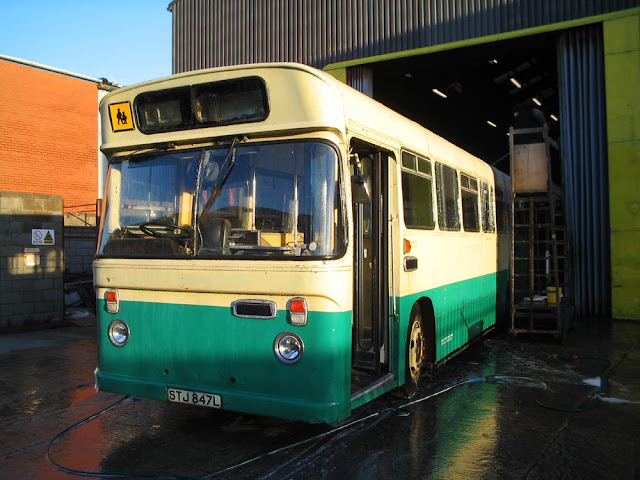
Most enthusiasts can trace their bus preferences back to early childhood influences and this is probably the only rationale explanation for my interest in Seddon RUs. Loved by Darlington and hated by just about every other operator, 274 of these were built, mostly with in house bodywork by Seddon's Pennine Coachcraft subsidiary. Crosville had 100 foist on it, LUT bought 50 (with Plaxton body) and most of the rest when to Northern municipals. The RU was a clone of the relatively successful Bristol RE but with a few particular failings. Most notable was the length of the prop shaft which was too short and led to failures, second was the brakes which were poorly balanced. Most went back to the manufacturers for rectification and by the time Lytham St. Annes bought its six most problems had been solved. However production soon came to an end with just five more for Hyndburn, eight for Darlington, two for Morecambe, one for Graham of Paisley and two for West Yorkshire PTE built. Darlington's lasted a full service life - most others were withdrawn prematurely after their seven year certificate of fitness expired. However this was not that uncommon amongst single deckers of that era as operators moved to double deckers.
Lytham six (45-50 STJ845-850L) were bought to convert routes 1 (Lytham to St. Annes via Ansdell) and 3 (Lytham to Spring Gardens via Fairhaven and St. Annes) to OMO operation in 1972. They also ran on existing OMO routes 2 (St. Annes to Smithy Lane) and 4 (St. Annes to Lytham Green Drive) and later on the trunk 11/11A (Blackpool to Lytham) routes too. At seven years old they required an overhaul and 46 was the first treated, in early 1979. 49 missed out due to serious accident damage sustained in 1978. 46 received single door conversion from B47D to B51F arrangement. 45, 47, 48 and 50 followed suit with the last not completed until early 1981. These four received a stylish variation of blue white and yellow livery adopted once Lytham St. Annes Corporation had grown into Fylde Borough Council in 1974.
The Seddons saw quite sparse use - Fylde had far too many vehicles for the work required, having built up a coach fleet using bus grant. This required the vehicles to spend six months of the year on bus work so in the winter Leopard coaches stood in for single deck buses and the Panthers, Seddons and REs didn't get much of a look in! That said it was something of a shock to hear that the Panthers and Seddons were to be withdrawn in spring 1982 to cut costs and reduce the losses being sustained. The five Seddon survivors came off in June and were parked up in the yard. Unlike most other Seddons an eager buyer was found for four - 45-47 and 50 headed south to Clydach near Swansea. 48 went to Crosville for spares, 49 was scrapped.
East End Garage of Clydach had acquired several of Burnley's Seddons and snapped up the four Fylde ones plus the operator's stock of spares. In 1991 it bought six of Darlington's eight, replacing several of the Burnley ones. In August 1997 I decided to visit on the off chance two of the Fylde ones were still there (45 and 46 have been disposed of earlier). I was not disappointed as 47 and 50 shared a line up with Darlington 62, 63 and 68 (plus spares donors 66 and 67). The last Burnley example RHG314K was tucked away withdrawn.
The general manager granted me permission to look round and opened up 47 for me - 15 or more years since I last set foot on one of these. He kindly agreed to keep it to one side when withdrawal came. Two years later a depot fire destroyed Darlington 63, 66 and 67 and badly damaged Fylde 50 - but 47 and the other two Darlingtons survived. By the end of 2000 47 was the only one in use and its MOT expired in January 2001 bringing over 28 years service (albeit quite easy service with 10 years at Fylde and 18 on school runs in South Wales!). True to his word, 47 was kept intact by the manager and was duly bought for preservation.
After a period stored in the West Midlands, 47 returned to the Fylde in 2003 and is now stored undercover at LTT's overspill storage depot. Restoration should be relatively straightforward and hopefully can start once the Trust's commitments for the Blackpool Tram anniversary in 2010 are met.